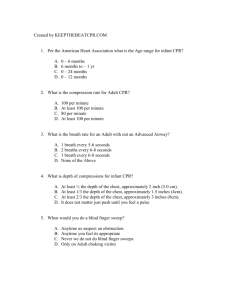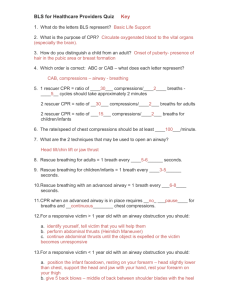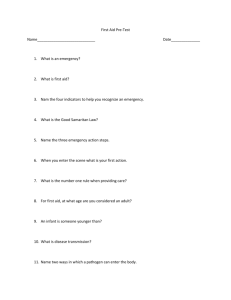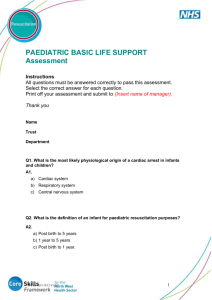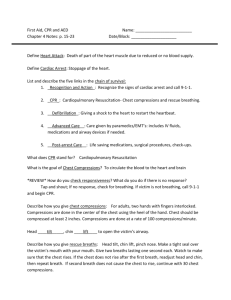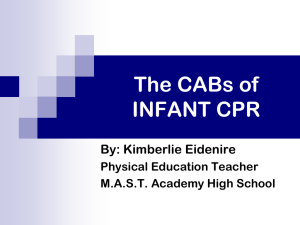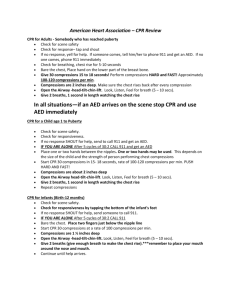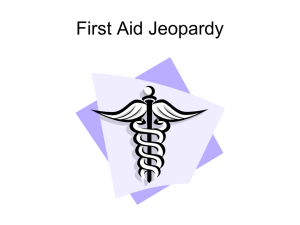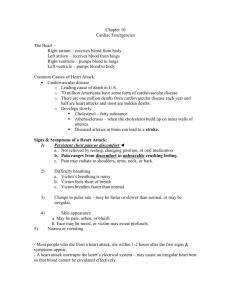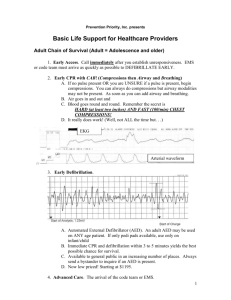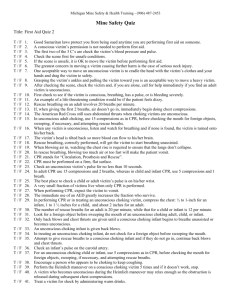CPR REVIEW / DISCUSSION QUESTIONS
advertisement
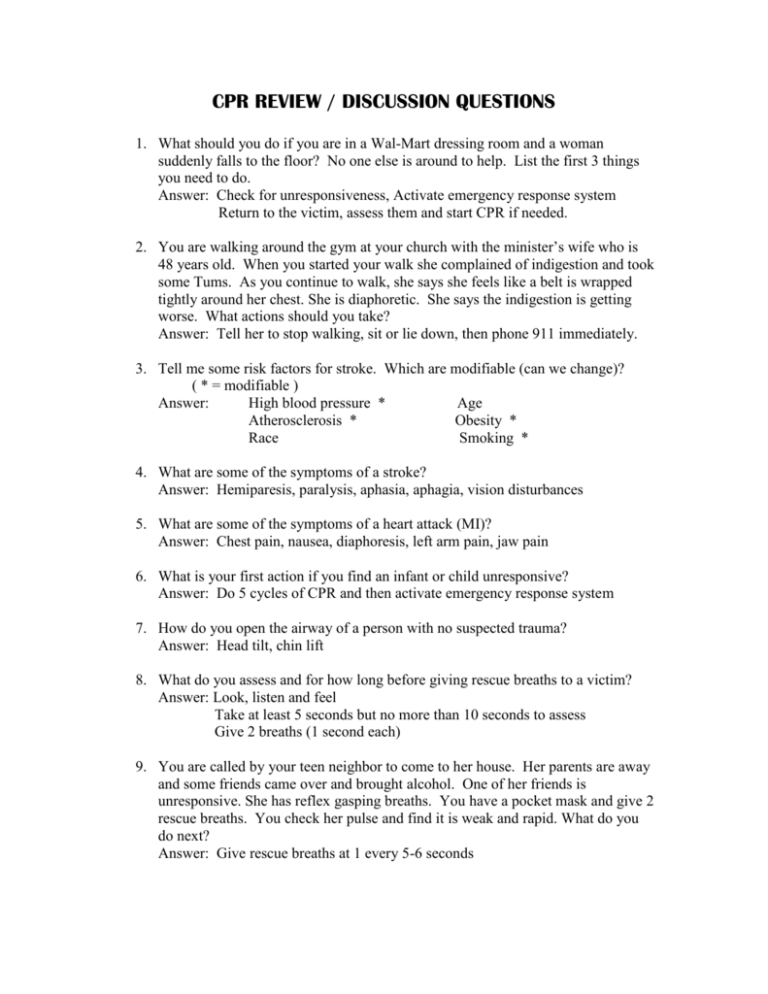
CPR REVIEW / DISCUSSION QUESTIONS 1. What should you do if you are in a Wal-Mart dressing room and a woman suddenly falls to the floor? No one else is around to help. List the first 3 things you need to do. Answer: Check for unresponsiveness, Activate emergency response system Return to the victim, assess them and start CPR if needed. 2. You are walking around the gym at your church with the minister’s wife who is 48 years old. When you started your walk she complained of indigestion and took some Tums. As you continue to walk, she says she feels like a belt is wrapped tightly around her chest. She is diaphoretic. She says the indigestion is getting worse. What actions should you take? Answer: Tell her to stop walking, sit or lie down, then phone 911 immediately. 3. Tell me some risk factors for stroke. Which are modifiable (can we change)? ( * = modifiable ) Answer: High blood pressure * Age Atherosclerosis * Obesity * Race Smoking * 4. What are some of the symptoms of a stroke? Answer: Hemiparesis, paralysis, aphasia, aphagia, vision disturbances 5. What are some of the symptoms of a heart attack (MI)? Answer: Chest pain, nausea, diaphoresis, left arm pain, jaw pain 6. What is your first action if you find an infant or child unresponsive? Answer: Do 5 cycles of CPR and then activate emergency response system 7. How do you open the airway of a person with no suspected trauma? Answer: Head tilt, chin lift 8. What do you assess and for how long before giving rescue breaths to a victim? Answer: Look, listen and feel Take at least 5 seconds but no more than 10 seconds to assess Give 2 breaths (1 second each) 9. You are called by your teen neighbor to come to her house. Her parents are away and some friends came over and brought alcohol. One of her friends is unresponsive. She has reflex gasping breaths. You have a pocket mask and give 2 rescue breaths. You check her pulse and find it is weak and rapid. What do you do next? Answer: Give rescue breaths at 1 every 5-6 seconds 10. You are eating lunch with a friend and she chokes on a shrimp. You attempt the Heimlich. She becomes limp and unresponsive. What do you do? Answer: Lower her to the ground, open the airway using the tongue-jaw lift and check for breathing. If you see the shrimp, remove it but do not do a blind finger sweep. Attempt to ventilate. If unsuccessful, reposition head and attempt to ventilate again. Start CPR!!!!! 11. How do you know you are providing enough air (ventilation volume) to a victim during rescue breathing? Answer: You should see the chest rise 12. What do you think is going on if, while performing CPR, the victim’s abdomen swells? Answer: You are delivering ventilations too quickly or too forcefully causing air to go into the abdomen 13. What is the compression rate for an adult, child or infant? Answer: 100 times per minute Compressions will be timed to be sure that 30 compressions are given in less than 23 seconds. 14. What is the compression depth for : An adultAnswer: 1 ½ to 2 inches A child or infant- Answer: 1/3 to ½ depth of chest 15. What technique should be used to perform chest compressions in: An adultAnswer: Heel of 1 hand, other hand on top Center of breastbone between nipples A childAnswer: Heel of 1 hand, may put other hand on top depending on size of victim Center of breastbone between nipples An infantAnswer: 2 fingers for 1 person 2 thumb with encircling hands for 2 person Just below nipple line on breastbone 16. What is the correct ratio of compressions to ventilations for: An adult1 or 2 rescuer Answer: 30:2 A child or infant: 1 rescuer Answer: 30:2 2 rescuer Answer: 15:2 Dev 5/02/SEB Rev 5/06/FEK CPR STUDY GUIDE Know the following: 1. Signs and symptoms of a heart attack and how to treat it 2. Signs and symptoms of a stroke and how to treat it 3. How to perform CPR (adult, infant and child [1 and 2 rescuer]) 4. How to assist a victim with an obstructed airway (adult, child and infant [conscious and unconscious]) 5. How to use an AMBU bag and pocket mask 6. How to use and AED (automatic external defibrillator) If there is no pulse on an adult victim, attach the AED, turn it on, follow the instructions. The best chance of survival in an adult victim is when CPR is started immediately and the defibrillator is there within 3-5 mins. Steps of CPR: 1. Determine unresponsiveness With an adult victim activate your emergency response system immediately (if alone, you will have to leave the victim). With a child or infant victim (if alone), give 5 cycles of CPR, then activate emergency response system. If someone else is present, have them activate emergency response system. 2. Open the Airway Use the head tilt-chin lift method for victim without trauma Use jaw thrust for suspected trauma or cervical injury 3. Check Breathing Look for chest to rise, listen and feel for breathing. Take at least 5 seconds but no more than 10 seconds. Give 2 breaths (1 second each). If the chest does not rise and fall, the airway may not be opened sufficiently. Reposition the airway and reattempt to ventilate. 4. Check for Circulation- check pulse for at least 5 secs but no more than 10 secs In the adult victim check carotid pulse for NO pulse In the child check carotid pulse for NO pulse OR for pulse < 60bpm with signs of poor perfusion In the infant check brachial pulse for NO pulse OR for pulse < 60bpm with signs of poor perfusion BEGIN COMPRESSIONS (see chart for location, method, depth, rate, ratio) Dev5/02SEB Rev5/06/FEK
